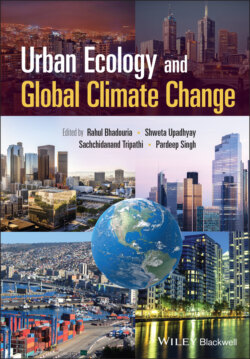Читать книгу Urban Ecology and Global Climate Change - Группа авторов - Страница 18
1.2.1.1 Urban Heat Islands
ОглавлениеModifications of the physical environment by the built structures during the process of urbanisation impede the energy distribution and composition of gases in the near‐surface. It alters the microclimatic conditions by modifying the thermodynamics of the urban ecosystems which resulted in 2–5 °C higher ambient temperature than the surroundings (countryside/rural) areas (Phelan et al. 2015; Jaganmohan et al. 2016; Vasishth 2015; Duffy and Chown 2016). Such alterations in local and regional climatic conditions (temperature dynamics) by the urban infrastructures lead to the UHI effect (Dallimer et al. 2016; Zhou et al. 2017; Hu et al. 2019). The UHI effect is one of the most prominent human‐made climatic phenomena in the urban ecosystems and has considerable ecological significance (Gaston et al. 2010; Akbari and Kolokotsa 2016; Yu et al. 2017). The UHI effect leads to the alteration of local and regional climatic conditions, impedes with the wind flows, and turbulence, related with shifts in cloud formation and precipitation, air pollution, and higher greenhouse gas (GHGs) emission (Seto and Shepherd 2009; Gaston et al. 2010). The increase in air pollution, heat stress, water quality, food security, and disparity in ecosystems services due to the UHI effects further affect the health and comfort of the urban inhabitants, thus, have adverse social, economic, and ecological impacts (Chang et al. 2016; Wong et al. 2016; Battles and Kolbe 2019). Moreover, UHI effect is further expected to contribute in the global climate change by increasing the GHGs (particularly CO2) emission from the urban areas (Rosenzweig et al. 2010), and in response, the UHI effect's impact may further intensify in most of the cities (Chapman et al. 2017). However, the magnitude of the UHI effect depends on several local and regional factors such the latitude, weather and climatic conditions, diurnal conditions, rainfall, surrounding ecology, population and culture of the city, and the urban planning (Zhao et al. 2014; Vasishth 2015). For example, the increase in temperatures due to UHI effects during winter at higher altitudes, and during summer at lower altitudes may decrease and increase the costs of air‐conditioning, respectively (Vasishth 2015). Thus, the UHI effects may have variable responses depending on the location of the urban area and it needs to be explored further under the changing environmental conditions.
